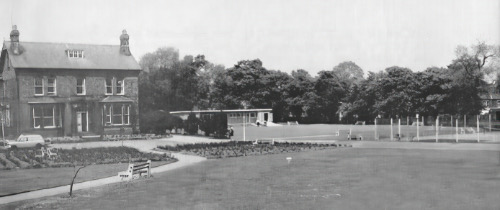
STANLEY URBAN DISTRICT COUNCIL OFFICES, OUTWOOD PARK
THROUGH THE CENTURIES
The earliest relics of prehistoric times found in the present Urban District were two collections of arrow heads and other flint's near Lee Mount.
Perhaps greater interest was a Bronze Age canoe which was recently recovered from the bed of the river Calder at Stanley Ferry.
With a squared stern and rounded bows, this measures some I8 feet in length. lt is now to be seen in the York Museum.
The people who settled here in the Bronze Age. well over 3,000 years ago, became part of the great Brigantes tribe of Britons.
They were friendly towards the Roman occupational legions but subsequently revolted and were subjugated.
Roman coins and moulds have been dug up near the former Stanley station, and there may well be a Roman site, either a villa or a farming settlement, on the nearby Roman Station Farm.
In Medieval Days
Like other parts of northern England, the area around Wrenthorpe suffered severely as a result of further uprisings following the Norman Conquest when William I ordered his army to carry out widespread devastation so that large areas lay waste here for many years afterwards.
The history of the manor of Wrenthorpe can be traced through the court rolls, early charters and other surviving records, and later from the parish registers, churchwardens’ accounts and other similar sources.
This was essentially an agricultural district with the various trades and crafts associated with farming and other rural undertakings.
Agriculture was worked on the open field system with strip cultivation.
As most of the workers were bondsmen or tenants of the lord of the manor, the arable land was farmed to a rigorously enforced pattern, with the long maintained but wasteful procedure of each strip of land being left fallow every third year in rotation.
The manor of Wrenthorpe passed through various ownerships, the manorial lords either occupying the manor house themselves or, more often, leasing the whole manor to other families.
Little seems to have disturbed the rural life of this district during those times. The workers toiled for long hours and little remuneration and had very poor living accommodation.
As the parish registers showed, their occupations continued to be associated almost entirely with agriculture, although later the cottagers and the farming families augmented their living by spinning and weaving the wool from the large flocks of sheep which were grazed on the valley slopes.
Later Times
From this the great Yorkshire woollen industry developed. Instead of working in their own homes the inhabitants were given employment in mills built along the river valleys where the flow of water supplied power for the looms.
Then the coal industry began to develop, and this soon changed the whole appearance and character of the districts where the rich seams occurred.
Improvements came slowly in the 18th and 19th centuries, first the turnpike trusts were set up to provide better roads, and this heralded the stage coach era.
Then came the enclosure of waste lands and commons into private ownership which caused considerable discontent.
With the further expansion of coal mining, railways were able to replace the coaches, whilst the industrial revolution laid the foundations of the great Yorkshire industries.
As a result there was widespread development of small terraced dwellings for the influx of workers. Within a short time hamlets had become townships and villages were expanded into growing towns.
The Board of Guardians, which had succeeded the churchwardens and local highway surveyors in the parishes, were no longer able to cope with the vital needs of the fast growing new communities, and various townships were combined, as at Stanley, to form self administering Urban Districts.
Stanley Urban District Council 1891 - 1978 covered an area of about 8 square miles.